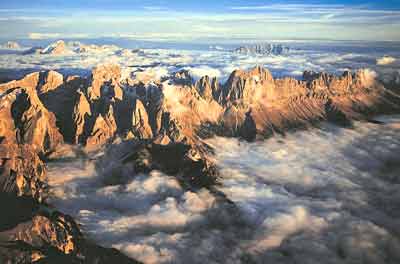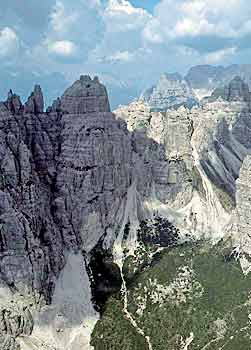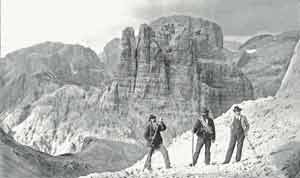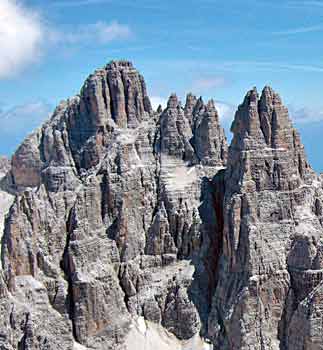| |

The Dolomites:
World Heritage, Our Heritage
by Giacomo Santini
On January 28 208 the autonomous provinces of Trento and Bolzano, together with the provinces of Belluno, Pordenone and Udine, finally established that the Dolomites belong to all and the time had come to reach agreement on protecting the mountains.
On that day the Ministry for the Environment and the Protection of the Land and Sea was sent an application for the Dolomites to be included in the list of UNESCO World Natural Heritage Sites, although the discussions began in 2004 and were developed over the following years.
The list of heritage sites comprises cultural or natural areas “considered to be of outstanding value to humanity”. Italy ratified the UNESCO Convention in Law 184 of 1977 and in doing so took on assumed significant responsibility, given the number and diversity of sites as described in the official document:
- Natural features consisting of physical and biological formations or groups of such formations which are of outstanding universal value from the aesthetic or scientific point of view.
- Geographical and physiographical formations and precisely delineated areas which constitute the habitat of threatened species of animals and plants of outstanding universal value from the point of view of science or conservation.
- Natural sites or precisely delineated areas of outstanding universal value from the point of view of science, conservation or natural beauty.
 The Dolomites fall under each of the three categories and yet more could be added in describing the beauty and value of the Alpine region. The Dolomites fall under each of the three categories and yet more could be added in describing the beauty and value of the Alpine region.
It goes without saying that we did not need this push for official recognition to remind us that we are part of a magical and unique park. Anyone who has donned a pair of hiking boots (if not an ice-pick and crampons) will have found themselves immersed in this natural resource, aware of both the privilege of the experience and the responsibility to safeguard it.
UNESCO recognition and the distinction of a “World Heritage Site” may be a source of pride, but it is also a source of responsibility. Indeed we, more than anybody else, are duty bound to protect and preserve this resource, to make it accessible to all without excess, to ensure that not only two-legged vandals but also the inexorable passage of time do not threaten the integrity of our heritage.
Recent years have seen some mountain areas reduced to dust down the sides of the largest summits, endangering those living in the area and destroying irreplaceable geological features. The disappearance of part of a mountain changes valley landscapes, undermines history and tradition and can even affect living conditions, as demonstrated by the climatic change that is often associated with landslides.
Going back to the recognition process, we ought to ask ourselves what it is that makes a given natural resource a “heritage”. According to the official definition:
“The criteria to identify candidate areas are geology (mountain groups consisting principally of dolomite rock and dolomite ladin formations), geomorphology (rock formations rising vertically to a height greater than 2000 above sea level, the presence of spectacular rock pinnacles and needles on the summit and broad gravel slopes at the base) and unity of landscape.
” Who is it, though, that makes these decisions? Trentino has a Steering Committee under the provincial administration. In addition, the criteria used in identifying candidate areas are determined by a permanent Inter-ministerial Working Group responsible for verifying the prior existence of protective legislation, or in other words, the existence of “a natural park or a site of communal importance as well as to ensure the unity of the resource in the case of areas crossing provincial borders”. criteria used in identifying candidate areas are determined by a permanent Inter-ministerial Working Group responsible for verifying the prior existence of protective legislation, or in other words, the existence of “a natural park or a site of communal importance as well as to ensure the unity of the resource in the case of areas crossing provincial borders”.
This method appears tailor made for the Dolomites insofar the area also meets the criteria on “conditions of integrity and authenticity, required by the UNESCO Operational Guidelines) as well as the  outstanding unique characteristics that can be scientifically demonstrated through an “Assessment and Declaration of outstanding universal value”. outstanding unique characteristics that can be scientifically demonstrated through an “Assessment and Declaration of outstanding universal value”.
In addition to these technical requirements we can add several historical and cultural aspects unique to the Dolomites. These include the literary heritage found in the narratives of thousands of Alpine expeditions begun centuries ago by English and Italian pioneers, as well as a wealth of popular tales featuring fairies, elves and gnomes inspired by the magical aura of the mountains.
Moreover, the area around the Dolomites is home to the Ladin people, who protect and pass on their unique culture, folklore and, most importantly, linguistic traditions. All these elements, combined with the natural beauty, constitute a fundamental part of the concept of “heritage” that is recognised and rewarded by UNESCO.
We must accept our role as “guardians of the temple” given our direct and personal relationship with the area’s nature and history - with that pinch of jealousy that keeps us vigil, but also conscious of our duty to share this resource with all those that wish to treat it with respect.
|
|